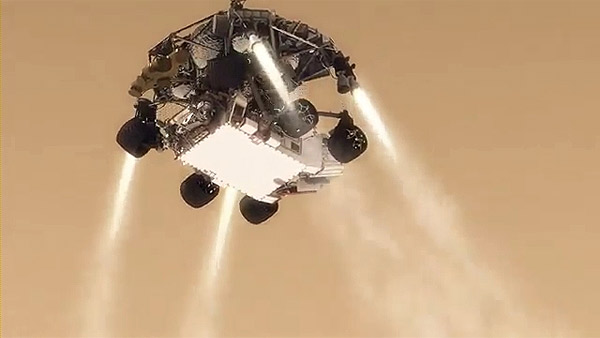NASA braces for ‘terror’ in Mars landing

Washington: The biggest, baddest space rover ever built for exploring an alien planet is nearing its August 6 landing on Mars, and the US space agency is anxious for success despite huge risks.
A popular Internet video by NASA called “Seven Minutes of Terror” depicts the high drama involved with the first-ever attempt to use a rocket-powered sky crane to lower the car-sized machine gently onto the surface of the Red Planet.
The $2.5 billion Mars Science Laboratory project combines a sophisticated rover, Curiosity, with a mobile chemistry kit to zap rocks and sift soil in the hunt for clues that life may once have existed on Mars.
“It is pretty crazy looking, I am the first to admit,” said Bill Nye, a well-known US science personality and president of the Planetary Society.
“But these people who did it are the best in the world, so I think they made engineering decisions that are pretty sound.”
The rover aims to explore the Gale Crater on Mars, which contains a low mountain and multiple layers of sediment that NASA scientists have said they expect will reveal the unknown history of Mars.
Scientists know much more about Mars today than they did 50 years ago, namely that ample amounts of water once existed there, increasing the likelihood that microbial life did too.
Future hopes for Mars exploration include drilling to see if water still runs beneath the surface.
For now, the one-ton (900 kilogram) rover’s toolkit contains a detector for water at 50 centimeters (20 inches) beneath the surface, plus lasers, sifters, drills and cameras to analyze rocks and send back images of the Martian surface as never before seen.
It is expected to land August 6 at 0531 GMT. NASA hopes it will get communications during the final minutes though a series of pings or tones that indicate when key milestones have been met.
The spacecraft must separate, a supersonic parachute must deploy to lower the rover down, then a rocket-powered sky crane must activate to power the vehicle closer to the surface before lowering it with nylon tethers.
It may be 15-20 minutes after the landing itself until NASA knows exactly what happened to its rover, which is twice the size of its vehicles Spirit and Opportunity. They launched in 2004 and landed with the help of airbags.
“This is really the first field test for the system. That is what has got me biting my nails,” said Howard McCurdy, a space historian and professor at American University.
“I can think of 100 ways it could go wrong. I can think of three or four ways it could go right.”
The mission has been in the works for 12 years, and was conceived following the crash of NASA’s Mars polar lander in 1999 when the US space agency regrouped and made plans for future attempts.
G. Scott Hubbard, professor at Stanford University and former NASA Mars program director who led the planning for the Mars Science Laboratory, said he feels something like a “proud papa,” but is still plenty nervous.
“They have tested this as much as you can possibly test it on Earth. You have to feel confident that you have done everything you can to ensure mission success,” Hubbard told AFP.
“But on the other hand, Mars is notorious for throwing you the unexpected. So there is a blanket of tension that sits over the top of everything.”
Indeed, more than half of global space agency attempts to send landers to Mars since 1960 have failed.
Bad surprises have ranged from dust storms to technical failures.
“Mars is hard,” said Nye, pointing out that Russia, despite all its firsts in the realm of space exploration, is “0 for 21 on Mars. Europe is 0 for 1. NASA is a little over 50 percent.”
But Mars remains a key focus of exploration because as Earth’s nearest neighbor, it is also the planet most likely to have harbored life in the past.
“It is not crazy to suggest that life started on Mars, got slung into space, and we are all descendants,” said Nye. “That is worth finding out.”
If the landing succeeds, experts say it would give new urgency and direction to NASA’s Mars program, which currently has one more orbiter, Maven, planned for launch in 2013 to hunt for methane in Mars’s atmosphere, but nothing after.
NASA recently bowed out of a joint project with Europe, called ExoMars, due to budgetary constraints, and faces more than $300 million in cuts to planetary science annually in the coming years.
“Other missions down the road have not yet been identified, so if this is successful, it will give momentum to doing more work on Mars,” said McCurdy.
If it fails, Hubbard said it could spark a reexamination of the US program, and may open the way for other space agencies to take the lead.
“I think the program would continue,” he said, describing Mars as “certainly the ultimate goal for human exploration beyond low Earth orbit.”






